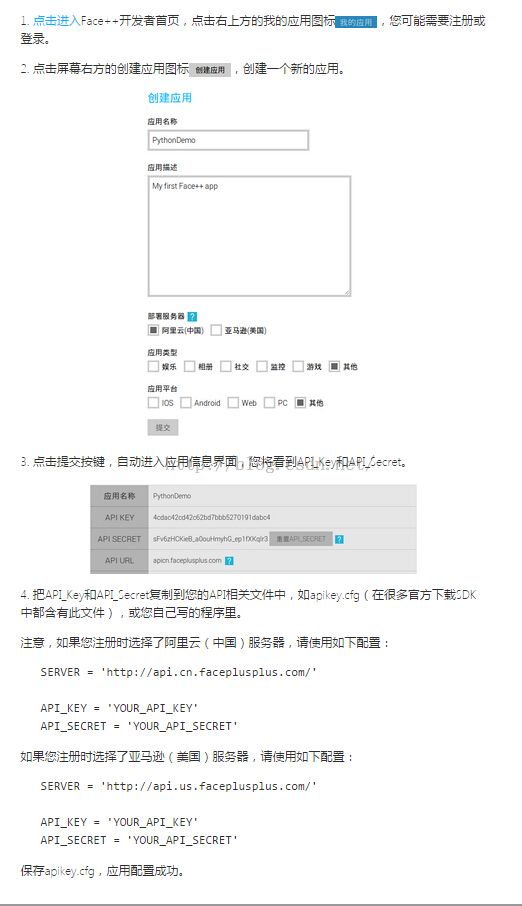用Face++实现人脸关键点检测
最近看了一篇很有意思的文章 http://matthewearl.github.io/2015/07/28/switching-eds-with-python/ ,本来想自己复现一下,后来发现自己太菜,用了一整天只完成了不到一半,最近要找工作了,看书看的有点烦,本来想写个有趣的代码放松下。哎。
开始正文。原作者用的是dlib的库完成关键点检测,试着装了一下,没装成,那就不用了。本来想用自己的库,后来想了下自己封装的太烂了,还是改用别人的吧,这样程序的大小也会小很多,训练好的文件还是比较大的。
首先去Face++注册一个账号,然后创建应用(得到访问的密钥),这里直接截图了。
我用的是Python 接口,去github下载SDK https://github.com/FacePlusPlus/facepp-python-sdk/tree/v2.0
修改apikey.cfg的内容,可以运行hello.py的历程。
注意服务器的地址不要选错,还有就是官方的历程里是这样的,API_KEY = '<YOUR_API_KEY>',替换直接的密钥时记得把<>也删掉,不然也会报错。
SDK的facepp.py文件的350行左右修改一下,添加 '/detection/landmark',这句,不然的话人脸关键点检测的接口无法调用。
这里稍微吐槽一下,Face++的SDK写的真不怎么好,很多地方不够详细,而且程序有时会因为网络问题出现bug。想上传自己的图片也找不到接口,官网只给了这么几句,
感觉解释的太简单了吧,SDK里也没有见到有相关的本地图片上传接口。
说了这么多,展示一下效果,然后贴代码。
由于开始选的两个脸对齐的比较好,所以换了一张,这里完成的效果是把第二幅图片的人脸缩放、旋转和第一张人脸对其。之后的操作就是裁剪、覆盖了。
下面贴一下代码,只为完成了一半(文章里写的这么多),后面的部分不太熟悉,要找工作了,没心情写代码。。。
这里建议大家自己注册一个账号,每个账号的开发者版本同时有3个线程,如果我这里修改了密钥程序应该会报错,这里可能程序无法运行。
#!/usr/bin/env python2 # -*- coding: utf-8 -*- # You need to register your App first, and enter you API key/secret. # 您需要先注册一个App,并将得到的API key和API secret写在这里。
API_KEY = 'de12a860239680fb8aba7c8283efffd9'
API_SECRET = '61MzhMy_j_L8T1-JAzVjlBSsKqy2pUap'
# Import system libraries and define helper functions
# 导入系统库并定义辅助函数
import time
import os
import cv2
import numpy
import urllib
import re
from facepp import API
ALIGN_POINTS = list(range(0,25))
OVERLAY_POINTS=list(range(0,25))
RIGHT_EYE_POINTS = list(range(2, 6))
LEFT_EYE_POINTS = list(range(4, 8))
FEATHER_AMOUNT = 11
SCALE_FACTOR = 1
COLOUR_CORRECT_BLUR_FRAC = 0.6
def encode(obj):
if type(obj) is unicode:
return obj.encode('utf-8')
if type(obj) is dict:
return {encode(k): encode(v) for (k, v) in obj.iteritems()}
if type(obj) is list:
return [encode(i) for i in obj]
return obj
def getPoints(text):
a=encode(text)
a=str(a)
#print a
x = re.findall(r'\'x\':......',a)
for i in range(len(x)):
x[i]=re.findall(r'\d+\.\d\d',x[i])
y = re.findall(r'\'y\':......',a)
for i in range(len(y)):
y[i]=re.findall(r'\d+\.\d\d',y[i])
xy =zip(x,y)
return xy
def drawPoints(img,xy): #画点,用于检测程序运行情况
Img = img
tmp = numpy.array(img)
h,w,c = tmp.shape
for i,j in xy:
xp=float(i[0])*w/100.
yp=float(j[0])*h/100.
point = (int(xp),int(yp))
cv2.circle(Img,point,1,(0,255,0))
return Img
def get_landmarks(path,tmpPic):
result = api.detection.detect(url = path,mode = 'oneface')
ID = result['face'][0]['face_id']
points = api.detection.landmark(face_id=ID,type = '25p')
xy = getPoints(points)
print 'downloading the picture....'
urllib.urlretrieve(path,tmpPic) #为防止图片内容有变化,每次都下载一遍,调试可以不用
tmp = cv2.imread(tmpPic)
#测试
Img = drawPoints(tmp,xy)
cv2.imwrite('point.jpg',Img)
tmp = numpy.array(tmp)
h,w,c = tmp.shape
points = numpy.empty([25,2],dtype=numpy.int16)
n=0
for i,j in xy:
xp=float(i[0])*w/100.
yp=float(j[0])*h/100.
points[n][0]=int(xp)
points[n][1]=int(yp)
n+=1
return numpy.matrix([[i[0], i[1]] for i in points])
#return points
def transformation_from_points(points1, points2):
"""
Return an affine transformation [s * R | T] such that:
sum ||s*R*p1,i + T - p2,i||^2
is minimized.
"""
# Solve the procrustes problem by subtracting centroids, scaling by the
# standard deviation, and then using the SVD to calculate the rotation. See
# the following for more details:
# https://en.wikipedia.org/wiki/Orthogonal_Procrustes_problem
points1 = points1.astype(numpy.float64)
points2 = points2.astype(numpy.float64)
c1 = numpy.mean(points1, axis=0)
c2 = numpy.mean(points2, axis=0)
points1 -= c1
points2 -= c2
s1 = numpy.std(points1)
s2 = numpy.std(points2)
points1 /= s1
points2 /= s2
U, S, Vt = numpy.linalg.svd(points1.T * points2)
# The R we seek is in fact the transpose of the one given by U * Vt. This
# is because the above formulation assumes the matrix goes on the right
# (with row vectors) where as our solution requires the matrix to be on the
# left (with column vectors).
R = (U * Vt).T
return numpy.vstack([numpy.hstack(((s2 / s1) * R,
c2.T - (s2 / s1) * R * c1.T)),
numpy.matrix([0., 0., 1.])])
def warp_im(im, M, dshape):
output_im = numpy.zeros(dshape, dtype=im.dtype)
cv2.warpAffine(im,
M[:2],
(dshape[1], dshape[0]),
dst=output_im,
borderMode=cv2.BORDER_TRANSPARENT,
flags=cv2.WARP_INVERSE_MAP)
return output_im
if __name__ == '__main__':
api = API(API_KEY, API_SECRET)
path1='http://www.faceplusplus.com/static/img/demo/17.jpg'
path2='http://www.faceplusplus.com/static/img/demo/7.jpg'
#path2='http://cimg.163.com/auto/2004/8/28/200408281055448e023.jpg'
tmp1='./tmp1.jpg'
tmp2='./tmp2.jpg'
landmarks1=get_landmarks(path1,tmp1)
landmarks2=get_landmarks(path2,tmp2)
im1 = cv2.imread(tmp1,cv2.IMREAD_COLOR)
im2 = cv2.imread(tmp2,cv2.IMREAD_COLOR)
M = transformation_from_points(landmarks1[ALIGN_POINTS],
landmarks2[ALIGN_POINTS])
warped_im2 = warp_im(im2, M, im1.shape)
cv2.imwrite('wrap.jpg',warped_im2)


